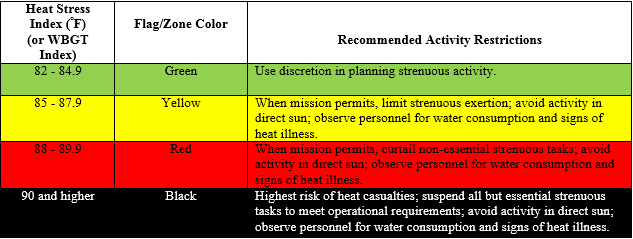GOODFELLOW AIR FORCE BASE, Texas -- Summer is upon us, and heat stress is a major problem we face during the hot months.
Heat stress is defined as any thermal stress above normal body temperature, primarily from environmental factors such as temperature, humidity, wind and heat from the sun. The body's response to these conditions depends on factors such as weight, physical fitness, age, alcohol consumption, medications and acclimatization to the weather. These factors determine reactions to working in hot conditions and it can be useful to learn other precautions to stay healthy and fit to fight.
There are ways to prevent these injuries before they happen. First and foremost, hydrate. Without hydration, even the most physically fit people are prone to heat stress. Hydration should take place according to light, medium and heavy workloads, not to exceed 1 quart of water per hour or 12 quarts per day.
Working can produce as much as 8 to 12 liters of sweat in a 24-hour period, so it is essential that water and salt intake be about equal to the sweat that is produced. To replace the loss of salt, sports drinks can be provided by workplaces along with water.
People conducting outdoor activities on particularly hot days should obtain information on the heat stress index and follow the preventive measures.
-- Drink plenty of water, consume small amounts frequently throughout the day.
-- Wear loose-fitting clothes.
-- Avoid alcohol and caffeinated beverages if engaging in strenuous activities.
-- Be aware of heat injury symptoms and first aid for heat injuries.
-- Slowly acclimate yourself to Texas heat, up to 7 days.
-- Modify activity schedules to perform the heaviest work at the coolest time of day.
The Mathis Fitness Center displays colored flags to represent the heat index zones upon notification of the heat stress advisory. The flag conditions are as follows:

The 17th Medical Operations Squadron Bioenvironmental Engineering Element monitors the Wet Bulb Globe Temperature index hourly once ambient temperatures outside reach 75 degrees.
The heat stress index is reported to the base command post, who reports this information to other base organizations via AtHoc notification.
For more information about heat stress, contact the 17th MDOS/BEE at 325-654-3126.